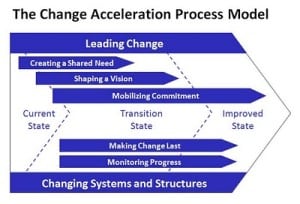Shaping your Vision and Defining your Project Plan
 The chart* to the right provides an overview of how to effectively lead change, ensuring the sustainability of a change initiative into the future.
The chart* to the right provides an overview of how to effectively lead change, ensuring the sustainability of a change initiative into the future.
As the chart illustrates, successful change initiatives begin by defining the need for change and shaping the vision for the future state of the company. This vision needs to be delivered in such a way that it mobilizes commitment amongst employees as well as your customers. ALL employees need to understand what value this change brings to the organization or conversely, the impact to the company if this change is not implemented.
From there, leading a successful change management initiative involves three factors:
- Capable Project Planning
- Clearly Defined Roles and Responsibilities
- Exceptional Communications Planning
Capable Project Leaders start by defining the Project Plan in terms of:
- Goals & Objectives
- Project Deliverables/Requirements
- Capturing the Voice of the Customer
- Establishing a Realistic Timeline
- Identifying the Project Team
Goals and Objectives
Establishing SMART (Specific, Measurable, Achievable, Relevant and Time-bound) goals and objectives narrows the focus for the project and clearly delineates what’s IN and what’s NOT IN for your change management initiative.
Project Deliverables/Requirements
Consider creating a Work Breakdown Structure (WBS) to help organize deliverables. The WBS starts at the top with Project Initiation and then defines (in excruciating detail) the specific tasks that need to occur for a project to be completed.
Capturing the Voice of the Customer
Many times a customer’s requirements are not at a level that can easily be measured from a business perspective. Therefore, it’s up to the business to collect Customer’s Needs, translate them into Customer Expectations, which in turn are translated into Customer Requirements that are useable by the business.
Establishing a Realistic Timeline
Using the WBS, construct a Network Diagram to show dependencies of the tasks (i.e., does one task have to be completed before the next task can begin or can they be done in parallel?). In addition to how long the project will take, the Network Diagram will show you the critical path (i.e., those tasks that define the project length).
Identifying the Project Team
As the Project Leader, it’s critical to ensure:
- The right resources are available at the right time.
- Clear priorities have been defined between your project and current responsibilities for each team member.
- Each team member has the available time to put towards the project.
Once your Project Plan has been defined, it’s then critical to clearly define roles and responsibilities within your company to support the Change Initiative. Tune in next week for this discussion.
*Chart: Becker, B., Huselid, M., and Ulrich, D. (2001), The HR Scorecard; Linking People, Strategy, and Performance. Harvard Business School Press, Boston, MA.
To the valgrubbandassociates.com owner, You always provide useful links and resources.